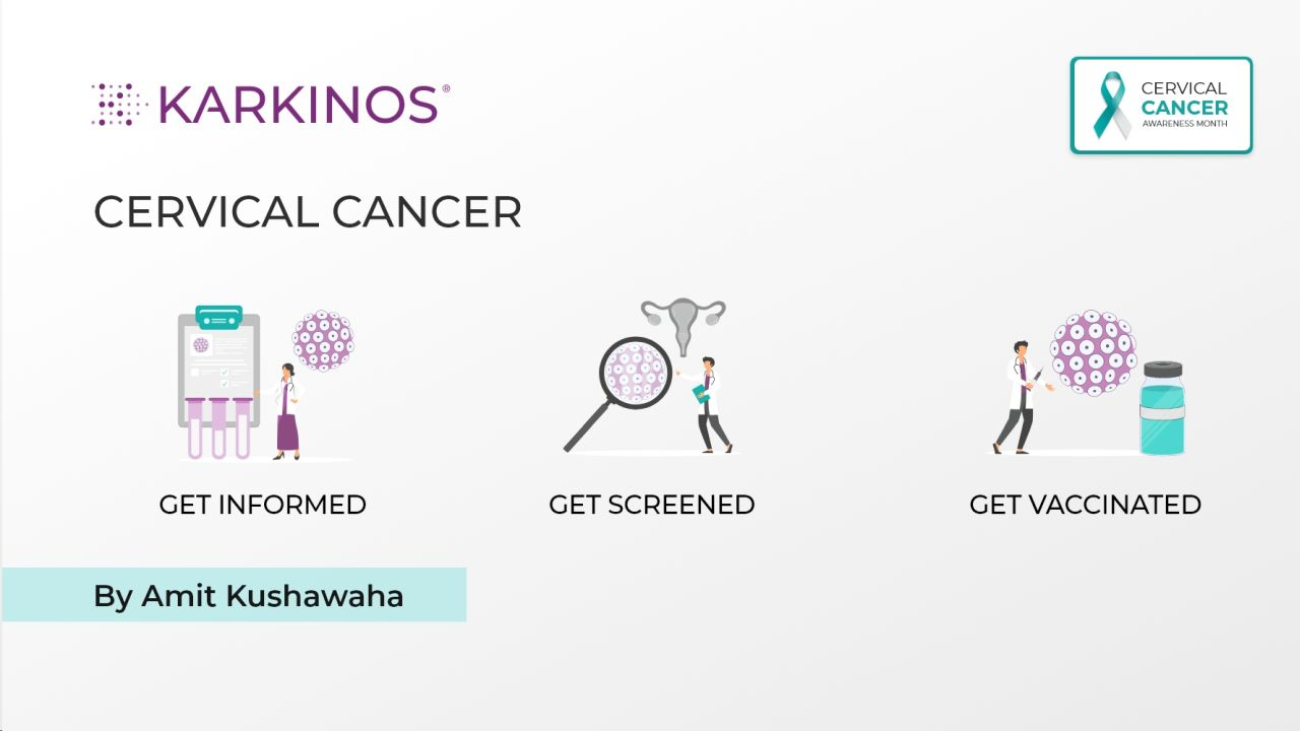Knocking cervical cancer off before it knocks in
By Amit Kushawaha, Growth Manager North – Women’s Wellness, Karkinos Healthcare
“Now it is cancer’s turn to be the disease that doesn’t knock before it enters, cancer that fills the role of an illness experienced as a ruthless, secret invasion — a role it will keep until, one day, its etiology becomes as clear and its treatment as effective as those of TB have become.”
– Susan Sontag (Illness as Metaphor)
Today we discuss a disease – a kind of cancer, indeed whose day has come, whose etiology remains known clearly and whose treatment is effective. The key word is to catch the build up of the disease in time.
A disease of neglect
Two decades ago, a prominent medical journal highlighted a stark reality: ‘Any deaths from cervical cancer today result from neglect.’ This neglect can manifest in women failing to prioritize regular screenings or experiencing lapses in the health system’s attention to abnormal results.
Cervical cancer is largely preventable, especially when detected early through routine screenings. Cases of cervical cancer are notably rare among women who consistently receive negative screening results. The unfortunate instances where women are afflicted with cervical cancer often trace back to a lack of screening altogether or a lapse in screenings within the preceding three years before the cancer diagnosis.
In today’s advanced healthcare landscape, it is unacceptable for any woman to succumb to cervical cancer. Karkinos Healthcare is therefore committed to ensure that no woman falls victim to this preventable condition in this digital era – from the perspective of both the individuals affected by the disease and the medical systems / professionals caring for them.
Cervical cancer is a preventable and curable disease if it is detected early and managed effectively. Most cervical cancers are associated with the Human Papilloma Virus (HPV) and the HPV vaccine can prevent most cases of cervical cancer if the vaccine is given before girls or women are exposed to the virus. Screening with highly sensitive tests and prevention through vaccination are two of the pillars of the Global Strategy adopted by WHO for the elimination of cervical cancer.
The urgency: High mortality, incidence, and low screening
Cervical cancer has been and continues to be one of the leading causes of cancer-related mortality in women across the globe. Globally, cervical cancer is the 4th most common cancer in women. In India, cervical cancer is the 2nd most common cancer in women and India contributes to the largest proportion of global cervical cancer burden.
While the precise cause of most human cancers remains elusive, hindering efforts for prevention, cervical cancer stands as a notable exception in our understanding. We know exactly what causes cervical cancer – an infection – HPV infection. HPV infection is a common infection in men and women. Fortunately, the infection recovers naturally because of our body’s immune actions.
As cervical cancer is preventable and largely curable, the World Health Organisation (WHO) has launched an elimination call by 2030, and to meet this goal, all stakeholders involved in cancer care have to hasten their pace of work.
In November 2020, WHO launched a Global strategy that entails the following targets for each of the three pillars for the 2030 call to elimination:
- 90% human papillomavirus (HPV) vaccination coverage of eligible girls,
- 70% screening coverage with a high-performance test and
- 90% of women with a positive screening test or a cervical lesion managed appropriately.
However, on the supply side, i.e., cervical cancer screening actually happening on ground, we see a stark reality in India on screening uptake in spite of witnessing the larger quantum and gravity of the problem. Responses from 7.6 lakhs women aged 15–49 years (during the National Family Health Survey (NFHS) – 5) showed that just 1.2% of them have undergone a screening test for cervical cancer. The survey also noted that screening is significantly more prevalent among the following demographics: educated, higher age group, high household wealth.
Ways to address: Screening and vaccination
Screening is a sieve, a rough sorting process to identify people in an apparently healthy population who are at higher risk of a health problem or a condition to enable early identification and treatment.
Cervical precancerous changes typically manifest without noticeable symptoms. Detection is possible solely through screening the cervix using early detection tests designed to identify women, who are at a higher risk of developing these precancerous changes.
The most widely used cervical screening tests include Pap Smear (conventional cervical cytology), testing for cancer causing HPV infection (HPV testing), Liquid Based Cervical Cytology (LBC) and Visual Inspection with 3-5% acetic acid (VIA).
The Pap Smear procedure entails gathering cells from the cervix’s surface using a small brush, creating a smear on a glass slide. This slide is then processed with special stains and examined under a microscope to identify any precancerous or cancerous changes in the cervical cell smear.
Liquid-based cytology (LBC) includes creating a suspension of collected cervical cells in a specialized medium. This mixture is processed to generate a thin layer of cells on a slide, which is then stained and examined under a microscope.
Visual Inspection with Acetic Acid (VIA) involves visually inspecting the cervix with the naked eye after applying dilute white vinegar (3-5% acetic acid). This process helps identify well-defined white lesions on the cervix, potentially indicating the presence of cervical intraepithelial neoplasia (CIN), which is the growth of abnormal cells on the surface of the cervix.
HPV testing entails the examination for the existence of one or more of the 14 high-risk types of HPV infection within gathered cervical cells. It is recognized as the most accurate, reproducible, and sensitive method for detecting cervical intraepithelial neoplasia (CIN) and adenocarcinoma in situ (AIS) when compared to Pap Smear, Liquid-based Cytology (LBC), and Visual Inspection with Acetic Acid (VIA). This cutting-edge technique allows for the precise identification of HPV DNA in tissue. Detection of HPV DNA serves as indisputable evidence confirming the presence of the infection. It is important to always remember that being infection positive doesn’t mean being cancerous. One should understand that cervical cancer is a rare outcome of HPV infection. Only persistent infection from certain high risk HPV may lead to cancer.
Among all cervical screening tests, HPV testing proves most efficient in identifying cervical precancerous changes. If HPV is identified, additional examinations, like a colposcopy, are advised to evaluate cervical cells for abnormalities. Treatment options, such as Thermal ablation or loop electrosurgical excision procedure (LEEP), may be recommended based on the findings.
Human Papillomavirus (HPV) vaccine has one of the highest per-person impacts on mortality of all vaccines. Given the vaccine’s unique characteristics and based on country experiences, HPV vaccination is an opportunity where our efforts can address national immunization, sexual and reproductive health, and cancer control programs.
Human Papillomavirus (HPV) vaccination is a crucial tool in the prevention of cervical cancer, a leading cause of cancer-related mortality in women globally. HPV vaccines, such as Gardasil, Cervarix, and Cervavac are designed to target specific HPV types, providing immunity against them. The vaccination is most effective when administered before an individual is exposed to HPV, ideally during preadolescence. This is why many National Immunization Programs recommend routine HPV vaccination for girls aged 9 to 14.
In addition to protecting against cervical cancer, HPV vaccination has been shown to reduce the incidence of other HPV-related cancers, such as vulvar, vaginal, anal, and oropharyngeal cancers. Moreover, vaccinating boys is endorsed by health authorities to further curb HPV transmission, providing indirect protection to both sexes.
Karkinos Healthcare’s approach: From evidence to practice
Karkinos Healthcare supports WHO’s call for elimination of cervical cancer. India accounts for the highest number of cervical cancer cases in Asia, followed by China, according to a latest Lancet study on the disease.
The company is enabling an approach that is accessible, breaks stigma based barriers, facilitates care continuum, and can operate at scale.
- Karkinos Healthcare provides a gold standard HPV DNA test to improve screening. Karkinos’ solution is a WHO prequalified FDA Approved highly sensitive solution delivered through Roche COBAS 6800.
- Karkinos also provides HPV Vaccination services. This includes Gardasil 4, Gardasil 9 and Cervavac.
- Karkinos has the ability to provide genomics – hereditary panel & NGS towards early detection & optimal treatment
While we have the clinical evidence for tests, we need programmes that enable end-to-end care and scale through use of technology. Karkinos addresses this need for a multi-pronged screening approach, which is a screening tool plus an awareness tool through its Risk Assessment app.
The company makes care accessible, and addresses barriers of stigma, while facilitating the care continuum with operations at scale through the Karkinos platform and programme operations.
In its endeavour to generate programme evidence that can benefit the entire nation for roll out models Karkinos has been supporting several initiatives in cervical health management. Some of the examples include :
- Karkinos Healthcare and IVDP (KH-IVDP) conduct a common cancer screening programme that will benefit around 3 lakh women. Through use of high-quality data enabled through technology women from self-help groups are able to avail our services to help them early detect cancer or identify their risk towards cancer development in their lifetime.
- Karkinos through its implementation partner Vishwanath Cancer Care Foundation supported promotion of cancer prevention among women prisoners in Madhya Pradesh.
- Karkinos Healthcare and Collectives For Integrated Livelihood Initiatives (CinI) collaborated to extend cancer care services, including screening and treatment, to the members of the Farmer Producer Companies (FPCs) in seven blocks within Jharkhand.
- Karkinos holds awareness and counselling sessions with public and private organisations and enables participants to access screening and vaccinations nationwide.
Call to action
It is crucial for women to assume personal responsibility in safeguarding themselves against this largely preventable cancer by participating in regular screening tests.
The month of January is Cervical Health Awareness Month. It is a perfect opportunity for every organisation to raise awareness about cervical cancer and HPV vaccination and act towards the same. Despite being a preventable and curable disease, cervical cancer is responsible for a large burden of suffering in women around the world, especially in low- and middle-income countries.
There is a need to get informed, get screened, and get vaccinated.
- Get informed: Find out the facts about cervical cancer and the human Papillomavirus (HPV) that causes it. Help educate other women in your life too.
- Get screened: Cervical cancer screening typically starts at age 30 and is repeated periodically. It is important to get screened with a high sensitive WHO recommended test. The World Health Organization endorses HPV testing as the primary choice among various screening tests. It is recommended for all seemingly healthy women aged 25 or 30 years and above, with the option of repeating the test every 5 or 10 years if the initial test shows no signs of infection.
- Get vaccinated: Getting vaccinated against cervical cancer is a proactive step that can significantly reduce the risk of developing cervical cancer. The vaccine is safe and effective, offering protection against certain strains of the human papillomavirus (HPV) that are known to cause cervical cancer.

 Amit Kushawaha is contributing towards cancer care as a Growth Manager for Women Wellness team at Karkinos Healthcare.
Amit Kushawaha is contributing towards cancer care as a Growth Manager for Women Wellness team at Karkinos Healthcare.